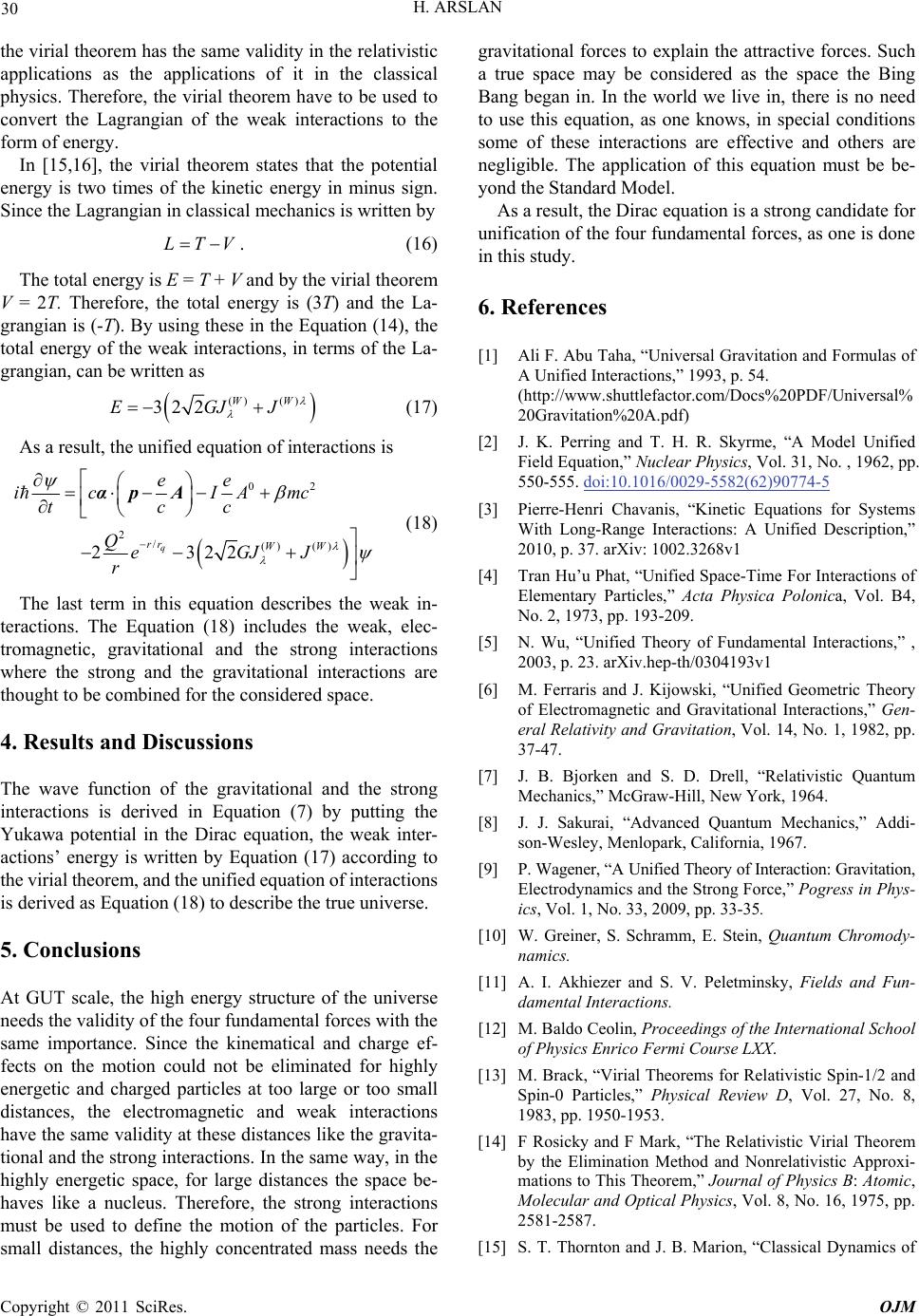
30 H. ARSLAN
the virial theorem has the same validity in the relativistic
applications as the applications of it in the classical
physics. Therefore, the virial theorem have to be used to
convert the Lagrangian of the weak interactions to the
form of energy.
In [15,16], the virial theorem states that the potential
energy is two times of the kinetic energy in minus sign.
Since the Lagrangian in classical mechanics is written by
LTV. (16)
The total energy is E = T + V and by the virial theorem
V = 2T. Therefore, the total energy is (3T) and the La-
grangian is (-T). By using these in the Equation (14), the
total energy of the weak interactions, in terms of the La-
grangian, can be written as
() ()
32 2WW
EGJJ
(17)
As a result, the unified equation of interactions is
02
2/() ()
2322
q
rr WW
ee
ic IAmc
tcc
QeGJJ
r
αpA
(18)
The last term in this equation describes the weak in-
teractions. The Equation (18) includes the weak, elec-
tromagnetic, gravitational and the strong interactions
where the strong and the gravitational interactions are
thought to be combined for the considered space.
4. Results and Discussions
The wave function of the gravitational and the strong
interactions is derived in Equation (7) by putting the
Yukawa potential in the Dirac equation, the weak inter-
actions’ energy is written by Equation (17) according to
the virial theorem, and the unified equation of interactions
is derived as Equation (18) to describe the true universe.
5. Conclusions
At GUT scale, the high energy structure of the universe
needs the validity of the four fundamental forces with the
same importance. Since the kinematical and charge ef-
fects on the motion could not be eliminated for highly
energetic and charged particles at too large or too small
distances, the electromagnetic and weak interactions
have the same validity at these distances like the gravita-
tional and the strong interactions. In the same way, in the
highly energetic space, for large distances the space be-
haves like a nucleus. Therefore, the strong interactions
must be used to define the motion of the particles. For
small distances, the highly concentrated mass needs the
gravitational forces to explain the attractive forces. Such
a true space may be considered as the space the Bing
Bang began in. In the world we live in, there is no need
to use this equation, as one knows, in special conditions
some of these interactions are effective and others are
negligible. The application of this equation must be be-
yond the Standard Model.
As a result, the Dirac equation is a strong candidate for
unification of the four fundamental forces, as one is done
in this study.
6. References
[1] Ali F. Abu Taha, “Universal Gravitation and Formulas of
A Unified Interactions,” 1993, p. 54.
(http://www.shuttlefactor.com/Docs%20PDF/Universal%
20Gravitation%20A.pdf)
[2] J. K. Perring and T. H. R. Skyrme, “A Model Unified
Field Equation,” Nuclear Physics, Vol. 31, No. , 1962, pp.
550-555. doi:10.1016/0029-5582(62)90774-5
[3] Pierre-Henri Chavanis, “Kinetic Equations for Systems
With Long-Range Interactions: A Unified Description,”
2010, p. 37. arXiv: 1002.3268v1
[4] Tran Hu’u Phat, “Unified Space-Time For Interactions of
Elementary Particles,” Acta Physica Polonica, Vol. B4,
No. 2, 1973, pp. 193-209.
[5] N. Wu, “Unified Theory of Fundamental Interactions,” ,
2003, p. 23. arXiv.hep-th/0304193v1
[6] M. Ferraris and J. Kijowski, “Unified Geometric Theory
of Electromagnetic and Gravitational Interactions,” Gen-
eral Relativity and Gravitation, Vol. 14, No. 1, 1982, pp.
37-47.
[7] J. B. Bjorken and S. D. Drell, “Relativistic Quantum
Mechanics,” McGraw-Hill, New York, 1964.
[8] J. J. Sakurai, “Advanced Quantum Mechanics,” Addi-
son-Wesley, Menlopark, California, 1967.
[9] P. Wagener, “A Unified Theory of Interaction: Gravitation,
Electrodynamics and the Strong Force,” Pogress in Phys-
ics, Vol. 1, No. 33, 2009, pp. 33-35.
[10] W. Greiner, S. Schramm, E. Stein, Quantum Chromody-
namics.
[11] A. I. Akhiezer and S. V. Peletminsky, Fields and Fun-
damental Interactions.
[12] M. Baldo Ceolin, Proceedings of the International School
of Physics Enrico Fermi Course LXX.
[13] M. Brack, “Virial Theorems for Relativistic Spin-1/2 and
Spin-0 Particles,” Physical Review D, Vol. 27, No. 8,
1983, pp. 1950-1953.
[14] F Rosicky and F Mark, “The Relativistic Virial Theorem
by the Elimination Method and Nonrelativistic Approxi-
mations to This Theorem,” Journal of Physics B: Atomic,
Molecular and Optical Physics, Vol. 8, No. 16, 1975, pp.
2581-2587.
[15] S. T. Thornton and J. B. Marion, “Classical Dynamics of
Copyright © 2011 SciRes. OJM